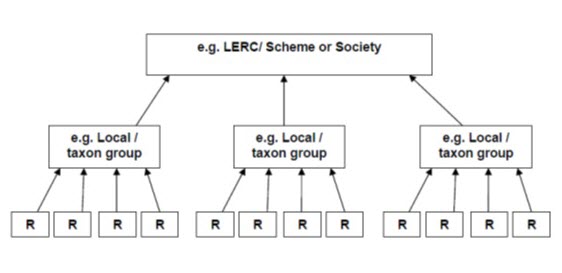Guidance for transfer, or direct submission, of historic data and data supplied by uncontactable data recorders to the NBN Atlas
Individual data recorders have Intellectual Property Rights (IPR) over the data they collect. In many cases, the NBN Data Partner (i.e. the person or organisation which provides data for the NBN Atlas) is not the person who collected the data and the recorder’s permission may be required before the data partner can transfer data from the NBN Gateway, or submit data directly, to the NBN Atlas1.
This document provides a summary of the guidance for data partners on the IPR of the data recorder and what they can do with historic data or data supplied by data recorders who they are no longer able to contact. It also summarises the IPR for “data collators”. More detail on the legal aspects of this guidance can be found in the document “NBN Guidance on Intellectual Property Rights – revised 31.08.18“.
Individual recorders
- Biodiversity data recorders have Intellectual Property Rights in the form of database2 rights, for the data they record.
- Database rights last for 15 years from the end of the year in which the last “substantial change” to the dataset was made. A substantial change could be as simple as adding new records to a notebook or spreadsheet etc., in which case the 15-year duration of database rights would restart every year a recorder adds records to their database. For example, if a recorder had a database containing records from 1970 and they were still adding to the dataset in 2017, the database rights for all of those records would be in force until at least 2032.
- Data provided over 15 years ago, if it has not undergone substantial changes to its content within the period since it was provided, are no longer subject to database rights and can legally be transferred or submitted to the NBN Atlas without the express permission of the data recorder.
- If it is not possible to contact the original data recorder and it is less than 15 years since the last “substantial change” to the database, the data cannot be transferred or submitted to the NBN Atlas.
- In cases where the data recorder has died, If the database has been updated at any point within the last 15 years, then database rights still apply and the data cannot be uploaded to the NBN Atlas. If the database was compiled as part of their work, the rights are transferred to their employer. If the database was passed on through the recorder’s will or as part of their estate, the rights are passed to the inheritor. In both cases the new rights holder can permit the transfer of the data. If the rights have not been transferred, they then pass to the Crown. Obtaining permission to transfer the data from the Bona Vacantia Division is possible but is likely to incur a fee and be a slow process.
- If database rights expire any Creative Commons licence associated with that database no longer apply and there is no restriction on its use.
Data Collators
For the purposes of this paper data collators refers to anyone who brings together data from a number of data recorders and compiles a new database with these data.
The rights of the data collators are largely determined by the agreements they have with the individuals or organisations who directly provide them with data
- Data collators also have IPR in the form of database rights for the combined database. In figure 1;

- The recorders (R) have database rights over their database
- The Local or taxon group (as examples) would have database rights in the database they have created from the four databases provided by the recorders
- The LERC or Scheme or Society (as examples) have database rights in the database they have created from the three databases provided by Local or Taxon groups
- The database rights for these databases are the same as point 2 above
- i.e. the recorders rights last for 15 years from their last update, the local/taxon groups rights last for 15 from the last update to their combined database and the LERCs/Scheme or Society’s last for 15 years from the last update of their dataset
- If database rights expire for one or more of the recorder’s database, it does not affect the database rights for the combined database it is a part of.
Footnotes:
1. Whether the data partner is required to seek permission from the data recorder before submitting data to the NBN Atlas will depend on the agreement the data provider has with the data recorder
2. A database is defined as a collection of independent works, data or materials which are arranged in a systematic or methodical way. Therefore, a notebook, an organised collection of pages or a simple excel spreadsheet would all be regarded as a database.
